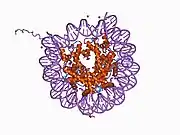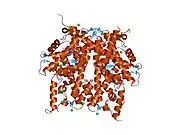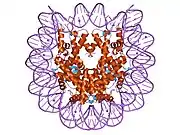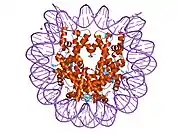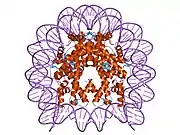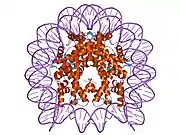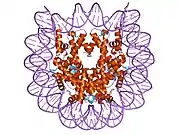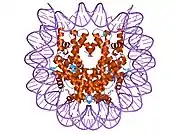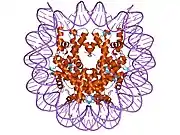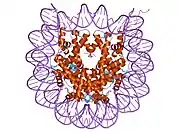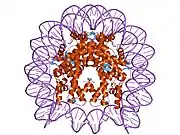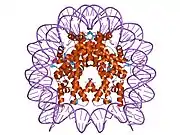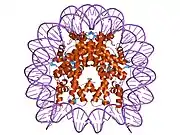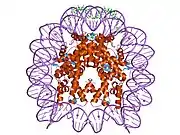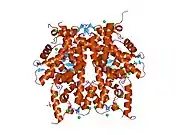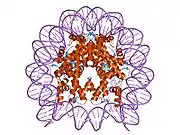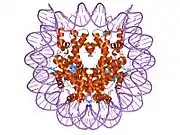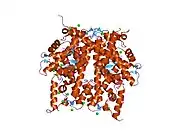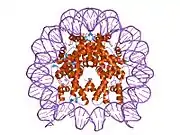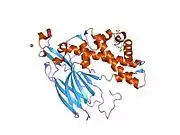Histone H3.3 is a protein that in humans is encoded by the H3F3A and H3F3B genes.[5] It plays an essential role in maintaining genome integrity during mammalian development.[6]
Histones are basic nuclear proteins that are responsible for the nucleosome structure of the chromosomal fiber in eukaryotes. Two molecules of each of the four core histones (H2A, H2B, H3, and H4) form an octamer, around which approximately 146 bp of DNA is wrapped in repeating units, called nucleosomes. The linker histone, H1, interacts with linker DNA between nucleosomes and functions in the compaction of chromatin into higher order structures. This gene contains introns and its mRNA is polyadenylated, unlike most histone genes. The protein encoded is a replication-independent member of the histone H3 family.[7]
Mutation of H3F3A are also linked to certain cancers. p.Lys27Met were discovered in Diffuse Intrinsic Pontine Glioma (DIPG),[8] where they are present 65-75% of tumors and confer a worse prognosis.[9] p.Lys27Met alterations in HIST1H3B and HIST1H3C, which code for histone H3.1 have also been reported in ~10% of DIPG.[10] H3F3A is also mutated in a smaller portion of pediatric and young adult high grade astrocytomas but more frequently as p.Gly34Arg/Val. Mutations in H3F3A and H3F3B are also found in chondroblastoma and giant cell tumor of bone.[11]
References
- 1 2 3 GRCh38: Ensembl release 89: ENSG00000163041 - Ensembl, May 2017
- 1 2 3 GRCm38: Ensembl release 89: ENSMUSG00000060743 - Ensembl, May 2017
- ↑ "Human PubMed Reference:". National Center for Biotechnology Information, U.S. National Library of Medicine.
- ↑ "Mouse PubMed Reference:". National Center for Biotechnology Information, U.S. National Library of Medicine.
- ↑ Wells D, Hoffman D, Kedes L (April 1987). "Unusual structure, evolutionary conservation of non-coding sequences and numerous pseudogenes characterize the human H3.3 histone multigene family". Nucleic Acids Research. 15 (7): 2871–89. doi:10.1093/nar/15.7.2871. PMC 340704. PMID 3031613.
- ↑ Jang CW, Shibata Y, Starmer J, Yee D, Magnuson T (July 2015). "Histone H3.3 maintains genome integrity during mammalian development". Genes & Development. 29 (13): 1377–92. doi:10.1101/gad.264150.115. PMC 4511213. PMID 26159997.
- ↑ "Entrez Gene: H3F3A H3 histone, family 3A".
- ↑ Wu G, Broniscer A, McEachron TA, Lu C, Paugh BS, Becksfort J, et al. (January 2012). "Somatic histone H3 alterations in pediatric diffuse intrinsic pontine gliomas and non-brainstem glioblastomas". Nature Genetics. 44 (3): 251–3. doi:10.1038/ng.1102. PMC 3288377. PMID 22286216.
- ↑ Khuong-Quang DA, Buczkowicz P, Rakopoulos P, Liu XY, Fontebasso AM, Bouffet E, et al. (September 2012). "K27M mutation in histone H3.3 defines clinically and biologically distinct subgroups of pediatric diffuse intrinsic pontine gliomas". Acta Neuropathologica. 124 (3): 439–47. doi:10.1007/s00401-012-0998-0. PMC 3422615. PMID 22661320.
- ↑ Buczkowicz P, Hoeman C, Rakopoulos P, Pajovic S, Letourneau L, Dzamba M, et al. (May 2014). "Genomic analysis of diffuse intrinsic pontine gliomas identifies three molecular subgroups and recurrent activating ACVR1 mutations". Nature Genetics. 46 (5): 451–6. doi:10.1038/ng.2936. PMC 3997489. PMID 24705254.
- ↑ Behjati S, Tarpey PS, Presneau N, Scheipl S, Pillay N, Van Loo P, et al. (December 2013). "Distinct H3F3A and H3F3B driver mutations define chondroblastoma and giant cell tumor of bone". Nature Genetics. 45 (12): 1479–82. doi:10.1038/ng.2814. PMC 3839851. PMID 24162739.
Further reading
- Zhang Y, Reinberg D (September 2001). "Transcription regulation by histone methylation: interplay between different covalent modifications of the core histone tails". Genes & Development. 15 (18): 2343–60. doi:10.1101/gad.927301. PMID 11562345.
- Wells D, Kedes L (May 1985). "Structure of a human histone cDNA: evidence that basally expressed histone genes have intervening sequences and encode polyadenylylated mRNAs". Proceedings of the National Academy of Sciences of the United States of America. 82 (9): 2834–8. Bibcode:1985PNAS...82.2834W. doi:10.1073/pnas.82.9.2834. PMC 397660. PMID 2859593.
- Ohe Y, Iwai K (October 1981). "Human spleen histone H3. Isolation and amino acid sequence". Journal of Biochemistry. 90 (4): 1205–11. doi:10.1093/oxfordjournals.jbchem.a133573. PMID 7309716.
- Kato S, Sekine S, Oh SW, Kim NS, Umezawa Y, Abe N, et al. (December 1994). "Construction of a human full-length cDNA bank". Gene. 150 (2): 243–50. doi:10.1016/0378-1119(94)90433-2. PMID 7821789.
- Albig W, Bramlage B, Gruber K, Klobeck HG, Kunz J, Doenecke D (November 1995). "The human replacement histone H3.3B gene (H3F3B)". Genomics. 30 (2): 264–72. doi:10.1006/geno.1995.9878. PMID 8586426.
- Palaparti A, Baratz A, Stifani S (October 1997). "The Groucho/transducin-like enhancer of split transcriptional repressors interact with the genetically defined amino-terminal silencing domain of histone H3". The Journal of Biological Chemistry. 272 (42): 26604–10. doi:10.1074/jbc.272.42.26604. PMID 9334241.
- Lin X, Wells DE (December 1997). "Localization of the human H3F3A histone gene to 1q41, outside of the normal histone gene clusters". Genomics. 46 (3): 526–8. doi:10.1006/geno.1997.5037. PMID 9441765.
- El Kharroubi A, Piras G, Zensen R, Martin MA (May 1998). "Transcriptional activation of the integrated chromatin-associated human immunodeficiency virus type 1 promoter". Molecular and Cellular Biology. 18 (5): 2535–44. doi:10.1128/mcb.18.5.2535. PMC 110633. PMID 9566873.
- Goto H, Tomono Y, Ajiro K, Kosako H, Fujita M, Sakurai M, et al. (September 1999). "Identification of a novel phosphorylation site on histone H3 coupled with mitotic chromosome condensation". The Journal of Biological Chemistry. 274 (36): 25543–9. doi:10.1074/jbc.274.36.25543. PMID 10464286.
- Lo WS, Trievel RC, Rojas JR, Duggan L, Hsu JY, Allis CD, et al. (June 2000). "Phosphorylation of serine 10 in histone H3 is functionally linked in vitro and in vivo to Gcn5-mediated acetylation at lysine 14". Molecular Cell. 5 (6): 917–26. doi:10.1016/S1097-2765(00)80257-9. PMID 10911986.
- Deng L, de la Fuente C, Fu P, Wang L, Donnelly R, Wade JD, et al. (November 2000). "Acetylation of HIV-1 Tat by CBP/P300 increases transcription of integrated HIV-1 genome and enhances binding to core histones". Virology. 277 (2): 278–95. doi:10.1006/viro.2000.0593. PMID 11080476.
- Lachner M, O'Carroll D, Rea S, Mechtler K, Jenuwein T (March 2001). "Methylation of histone H3 lysine 9 creates a binding site for HP1 proteins". Nature. 410 (6824): 116–20. Bibcode:2001Natur.410..116L. doi:10.1038/35065132. PMID 11242053. S2CID 4331863.
- Zhong S, Zhang Y, Jansen C, Goto H, Inagaki M, Dong Z (April 2001). "MAP kinases mediate UVB-induced phosphorylation of histone H3 at serine 28". The Journal of Biological Chemistry. 276 (16): 12932–7. doi:10.1074/jbc.M010931200. PMID 11278789.
- Suzuki H, Fukunishi Y, Kagawa I, Saito R, Oda H, Endo T, et al. (October 2001). "Protein-protein interaction panel using mouse full-length cDNAs". Genome Research. 11 (10): 1758–65. doi:10.1101/gr.180101. PMC 311163. PMID 11591653.
- Deng L, Wang D, de la Fuente C, Wang L, Li H, Lee CG, et al. (October 2001). "Enhancement of the p300 HAT activity by HIV-1 Tat on chromatin DNA". Virology. 289 (2): 312–26. doi:10.1006/viro.2001.1129. PMID 11689053.
- Bauer UM, Daujat S, Nielsen SJ, Nightingale K, Kouzarides T (January 2002). "Methylation at arginine 17 of histone H3 is linked to gene activation". EMBO Reports. 3 (1): 39–44. doi:10.1093/embo-reports/kvf013. PMC 1083932. PMID 11751582.
- Zegerman P, Canas B, Pappin D, Kouzarides T (April 2002). "Histone H3 lysine 4 methylation disrupts binding of nucleosome remodeling and deacetylase (NuRD) repressor complex". The Journal of Biological Chemistry. 277 (14): 11621–4. doi:10.1074/jbc.C200045200. PMID 11850414.
- Goto H, Yasui Y, Nigg EA, Inagaki M (January 2002). "Aurora-B phosphorylates Histone H3 at serine28 with regard to the mitotic chromosome condensation". Genes to Cells. 7 (1): 11–7. doi:10.1046/j.1356-9597.2001.00498.x. PMID 11856369. S2CID 23717416.





